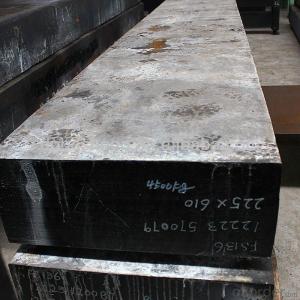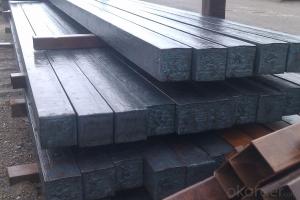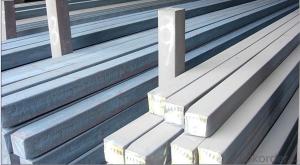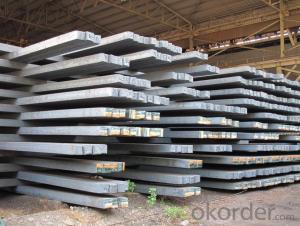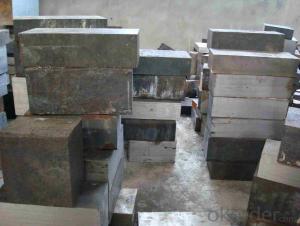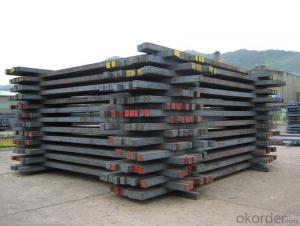Prime square alloy steel billet 115mm Q235
- Loading Port:
- Shanghai
- Payment Terms:
- TT OR LC
- Min Order Qty:
- 100 m.t.
- Supply Capability:
- 10000 m.t./month
OKorder Service Pledge
OKorder Financial Service
You Might Also Like
Structure of Prime square alloy steel billet 115mm Q235

Description of Prime square alloy steel billet 115mm Q235
1) Excellent corrosion resistance: The zinc layer provides a good protection of Pre-painted Galvanizeed Steel Sheet.
2) High heat resistance: The reflective surface of the material aids in efficiently reflecting the sunlight away and in turn reducing the amount of heat transmitted. The thermal reflectivity converts into energy savings.
3) Aesthetics: Pre-Painted Galvanized steel sheet is available in plethora of patterns and multiple sizes as per the requirements that given by our customers.
4) Versatility: can be used in the various areas.

Main Feature of Prime square alloy steel billet 115mm Q235
Uncoated CR steel sheet
With the features of in line with the international highest standards in demension and shape, excellent surface finish and properties, the products are mainly used in home appliance and automobile industries.
Galvanized steel sheet(include HDG and EG)
With the features of good corrosion resistance, the products are mainly used in automobile, home appliance, electronics, building and machinery manufacture industries, etc.
Precoated steel sheet
With the features of enviromental protection and good processablility, long lasting surface durability, rich in colors, the products are maily used in building, home appliance and furniture industries, etc.
Applications of Prime square alloy steel billet 115mm Q235
1) Excellent corrosion resistance: The zinc layer provides a good protection of Pre-painted Galvanizeed Steel Sheet.
2) High heat resistance: The reflective surface of the material aids in efficiently reflecting the sunlight away and in turn reducing the amount of heat transmitted. The thermal reflectivity converts into energy savings.
3) Aesthetics: Pre-Painted Galvanized steel sheet is available in plethora of patterns and multiple sizes as per the requirements that given by our customers.
4) Versatility: can be used in the various areas.

Specifications of Prime square alloy steel billet 115mm Q235
Product | Billet |
Material Grade | SGCC / SGCH / DX51D+AZ, etc |
Thickness | 0.6-3.0mm |
Width | 500-1500mm |
Tolerance | Thickness: +/-0.02mm , Width:+/-2mm |
Zinc-coating | Z30-150g/m2 |
Technique | Raw material: Hot rolled steel coil --> Cold rolled_>hot dipped galvalume |
Surface | Dried, Chromated, Unoiled |
Spangle | Regular spangle , small spangle, zero spangle |
ID | 508MM 610MM |
Coil weight | 1-25MT |
Export package | Cardboard inner sleeves, Waterproof paper, galvanized steel covered and steel strip packed |
FAQ of Prime square alloy steel billet 115mm Q235
We have organized several common questions for our clients,may help you sincerely:
1. How Can I Visit There?
Our company is located in Tianjin City, China, near Beijing. You can fly to Tianjin Airport Directly. All our clients, from home or aboard, are warmly welcome to visit us!
2. How Can I Get Some Sample?
We are honored to offer you sample.
3. Why choose CNBM?
we always fix steel produce in container well to make it safe arrive at destination port
we always provide best and professional forward service for our buyer
we always apply 14days free detention for our buyers container in destination
we provide one set After-sales service for our buyer
we provide China inland steel market price report
we help our buyer become number one in local market .
- Q:What is Alfa carbon? What is beta carbon?
- Alfa is directly connected with the functional groups of carbon atoms of carbon atoms, such as CH3CH2COOH CH2 in which methylene propionate is Alfa carbon carbon carbon atom is the beta carbon atom is directly connected with the functional groups and the connection of the carbon (around Kazakhstan), such as the CH3CH2COOH CH3 propionic acid methyl carbon is the beta carbon
- Q:Can steel billets be used in the production of energy-efficient appliances?
- Certainly, energy-efficient appliances can make use of steel billets. Steel, being a versatile material renowned for its strength and durability, is extensively employed in appliance manufacturing. These appliances are designed to minimize energy consumption and greenhouse gas emissions by employing less energy while performing their designated tasks. When it comes to energy-efficient appliances, steel billets can be processed and transformed into numerous components, including outer shells, structural supports, and internal parts. The incorporation of steel ensures the longevity and dependability of these appliances, thereby enhancing their overall energy efficiency. Moreover, steel is highly recyclable, allowing it to be repurposed or reused for other applications once an appliance reaches the end of its lifecycle. Steel recycling aids in energy conservation and waste reduction, further bolstering the pursuit of energy efficiency. To summarize, the utilization of steel billets is indeed feasible in the production of energy-efficient appliances. The exceptional properties of steel, namely its strength, durability, and recyclability, make it an ideal choice for manufacturing appliances that promote a more sustainable future.
- Q:How are steel billets used in the manufacturing of mining equipment?
- Steel billets are used in the manufacturing of mining equipment as they serve as the starting material for various components. These billets are first heated and then shaped into desired forms such as gears, shafts, or frames, which are crucial for the construction of heavy-duty mining machinery. The strength and durability of steel make it an ideal choice for withstanding the harsh conditions and rigorous demands of mining operations.
- Q:What are the different methods of steel billet casting?
- There are several different methods of steel billet casting that are commonly used in the industry. These methods include continuous casting, ingot casting, and direct casting. Continuous casting is the most widely used method of steel billet casting. In this process, molten steel is poured into a water-cooled mold, which is usually made of copper. As the steel solidifies, a continuous billet is formed, which is then cut into desired lengths. Continuous casting allows for a high production rate and precise control over the dimensions and quality of the billets. Ingot casting is another method of steel billet casting, which involves pouring molten steel into individual molds to create ingots. These ingots are then allowed to solidify before being reheated and hot rolled into billets. Ingot casting is commonly used for small-scale production or for specialty steel alloys that require specific compositions. Direct casting, also known as strand casting, is a newer method of steel billet casting that eliminates the need for solidification and reheating processes. In this method, molten steel is directly cast into billets through a series of water-cooled copper molds. The billets are then cooled and cut to the desired lengths. Direct casting offers advantages such as reduced energy consumption and improved yield, as it eliminates the intermediate steps of ingot casting. Overall, the choice of steel billet casting method depends on factors such as production volume, desired quality, and specific requirements of the steel alloy being produced. Each method has its own advantages and limitations, and the selection of the appropriate method is crucial for ensuring efficient and cost-effective steel billet production.
- Q:What are the different methods of shaping steel billets?
- There exist various techniques for shaping steel billets, each possessing its own benefits and applications. Common methods include forging, rolling, extrusion, and casting. 1. Forging involves applying pressure through hammers or presses to shape the steel billet. This technique allows for precise shaping, producing complex shapes with high strength and durability. It finds extensive use in manufacturing components for the automotive, aerospace, and construction industries. 2. Rolling entails passing the steel billet through a series of rollers to reduce its thickness and shape it into different forms like sheets, plates, or bars. This method is highly efficient, capable of producing large quantities of steel products with consistent dimensions and surface finish. It is commonly employed in the production of structural steel, pipes, and tubes. 3. Extrusion involves forcing the steel billet through a die to create the desired shape. This technique is particularly suitable for producing long and continuous profiles with complex cross-sections, such as rods, tubes, and wire. It allows for precise control over the shape and dimensions of the final product and is commonly used in manufacturing aluminum window frames, automotive parts, and electrical conductors. 4. Casting entails pouring molten steel into a mold and allowing it to solidify into the desired shape. This process is versatile, capable of producing intricate and large-scale components with minimal material waste. Casting is commonly used in the production of steel ingots, pipes, and large structural components. These various methods of shaping steel billets offer distinct advantages in terms of efficiency, precision, and versatility. The choice of method depends on specific requirements for the desired steel product, including size, shape, strength, and cost-effectiveness.
- Q:What is the typical impact strength of a steel billet?
- The typical impact strength of a steel billet varies depending on the specific grade and composition of the steel. In general, steel billets exhibit a high level of toughness and can withstand significant impact forces without fracturing or breaking. This is due to the inherent strength and ductility of steel as a material. However, it is important to note that the impact strength of a steel billet can be further enhanced through various processes such as heat treatment or alloying. These processes can help improve the material's resistance to impact, making it even more durable and suitable for demanding applications. Ultimately, it is crucial to consider the specific grade and composition of the steel billet in order to determine its exact impact strength. Different steel grades are designed for different purposes, and their impact strength can vary accordingly. Therefore, it is recommended to consult the manufacturer or refer to the material specifications to obtain accurate and detailed information regarding the typical impact strength of a particular steel billet.
- Q:Can steel billets be used in the aerospace industry?
- Yes, steel billets can be used in the aerospace industry. Steel billets are a semi-finished product that can be further processed into various components and structures required for aerospace applications. Steel is known for its high strength, durability, and heat resistance, which are crucial properties for aerospace materials. Steel billets can be used to manufacture various aerospace components such as engine parts, landing gear, structural frames, and fasteners. Additionally, steel's availability and cost-effectiveness make it an attractive choice for certain aerospace applications. However, it is important to note that the specific requirements and standards of the aerospace industry must be met when using steel billets to ensure the highest level of safety and reliability.
- Q:What are the different surface finishes available for tool steel billets?
- There are several surface finishes available for tool steel billets, including mill finish, hot rolled, cold rolled, ground, and polished. Each finish has its own characteristics and is used for specific purposes. Mill finish is the raw surface of the billet after it has been manufactured, while hot rolled has a rougher texture due to the high temperature rolling process. Cold rolled billets have a smoother surface and tighter dimensional tolerances. Ground finish involves grinding the surface to achieve a specific level of smoothness and precision. Finally, polished finish provides the highest level of smoothness and reflectivity, often used for aesthetic purposes or in applications requiring minimal friction.
- Q:What is the typical production process for steel billets?
- The typical production process for steel billets involves several steps. First, raw materials such as iron ore, coal, and limestone are obtained. These materials are then processed and transformed into iron through a blast furnace or direct reduction process. The iron is further refined in a basic oxygen furnace or an electric arc furnace to remove impurities and adjust the composition. Once the iron is refined, it is cast into large rectangular molds known as ingots. These ingots are then heated and rolled into semi-finished products called blooms or slabs. Blooms are typically square or rectangular in shape, while slabs are flat and rectangular. The next step is to further process the blooms or slabs into billets. This is done by reheating the semi-finished products and passing them through a series of rolling mills. The rolling mills apply pressure to shape the metal and reduce its thickness. This process is known as hot rolling. After hot rolling, the billets are cooled and inspected for any defects. They may undergo additional processes such as surface treatment or heat treatment to improve their properties. The billets are then typically cut into desired lengths and stored before further processing or shipment to customers. Overall, the production process for steel billets involves obtaining raw materials, refining the iron, casting it into semi-finished products, hot rolling, and final inspection and processing. This process ensures that the steel billets meet the required specifications and quality standards before they are used for various applications in industries such as construction, automotive, and manufacturing.
- Q:How do steel billets contribute to the manufacturing of electrical appliances?
- The manufacturing of electrical appliances heavily relies on steel billets, as they offer a strong and long-lasting material for different components. Robust structures are crucial for electrical appliances like refrigerators, washing machines, and air conditioners, as they need to withstand continuous usage and external forces. To create these sturdy structures, semi-finished metal products called steel billets are employed as raw materials in the manufacturing process. To begin with, steel billets are shaped and sized through forging or rolling to produce the frames, chassis, and housing of electrical appliances. These components provide vital support and protection for the internal parts of the appliances. Due to its strength and stability, steel is an ideal choice to endure the weight and vibrations generated during the operation of electrical appliances. Moreover, steel billets are utilized for fabricating the motor cores and transformer cores in electrical appliances. Motor cores play a crucial role in converting electrical energy into mechanical energy, whereas transformer cores regulate voltage in electrical circuits. Steel's magnetic properties, such as high electrical conductivity and low hysteresis loss, make it an excellent option for these applications, ensuring efficient energy conversion and transmission. Furthermore, steel billets are employed in the manufacturing of heating elements and electrical contacts in appliances like stoves, ovens, and switches. These components demand materials that can withstand high temperatures, resist corrosion, and exhibit excellent electrical conductivity. Steel billets are often alloyed with other metals like nickel or chromium to enhance these properties, making them highly suitable for such applications. In conclusion, steel billets make a significant contribution to the manufacturing of electrical appliances by providing a durable and versatile material for various components. The strength, stability, and magnetic properties of steel make it an essential raw material for creating the frames, motor cores, transformer cores, heating elements, and electrical contacts used in these appliances. Thanks to steel billets, electrical appliances can perform reliably and efficiently, meeting the needs and expectations of consumers.
1. Manufacturer Overview |
|
|---|---|
| Location | |
| Year Established | |
| Annual Output Value | |
| Main Markets | |
| Company Certifications | |
2. Manufacturer Certificates |
|
|---|---|
| a) Certification Name | |
| Range | |
| Reference | |
| Validity Period | |
3. Manufacturer Capability |
|
|---|---|
| a)Trade Capacity | |
| Nearest Port | |
| Export Percentage | |
| No.of Employees in Trade Department | |
| Language Spoken: | |
| b)Factory Information | |
| Factory Size: | |
| No. of Production Lines | |
| Contract Manufacturing | |
| Product Price Range | |
Send your message to us
Prime square alloy steel billet 115mm Q235
- Loading Port:
- Shanghai
- Payment Terms:
- TT OR LC
- Min Order Qty:
- 100 m.t.
- Supply Capability:
- 10000 m.t./month
OKorder Service Pledge
OKorder Financial Service
Similar products
New products
Hot products
Related keywords
